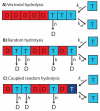Regulation of Microtubule Growth and Catastrophe: Unifying Theory and Experiment
- PMID: 26616192
- PMCID: PMC4783267
- DOI: 10.1016/j.tcb.2015.08.009
Regulation of Microtubule Growth and Catastrophe: Unifying Theory and Experiment
Abstract
Recent studies have found that microtubule-associated proteins (MAPs) can regulate the dynamical properties of microtubules in unexpected ways. For most MAPs, there is an inverse relationship between their effects on the speed of growth and the frequency of catastrophe, the conversion of a growing microtubule to a shrinking one. Such a negative correlation is predicted by the standard GTP-cap model, which posits that catastrophe is due to loss of a stabilizing cap of GTP-tubulin at the end of a growing microtubule. However, many other MAPs, notably Kinesin-4 and combinations of EB1 with XMAP215, contradict this general rule. In this review, we show that a more nuanced, but still simple, GTP-cap model, can account for the diverse regulatory activities of MAPs.
Figures




References
-
- Hirokawa N, Tanaka Y. Kinesin superfamily proteins (KIFs): Various functions and their relevance for important phenomena in life and diseases. Exp. Cell Res. 2015 DOI: 10.1016/j.yexcr.2015.02.016. - PubMed
-
- Wang Z-X, et al. Axonal transport defects in Alzheimer’s disease. Mol. Neurobiol. 2015;51:1309–1321. - PubMed
-
- De Vos KJ, et al. Role of Axonal Transport in Neurodegenerative Diseases*. Annu. Rev. Neurosci. 2008;31:151–173. - PubMed
-
- Desai a, Mitchison TJ. Microtubule polymerization dynamics. Annu. Rev. Cell Dev. Biol. 1997;13:83–117. - PubMed
Publication types
MeSH terms
Substances
Grants and funding
LinkOut - more resources
Full Text Sources
Other Literature Sources
Miscellaneous

